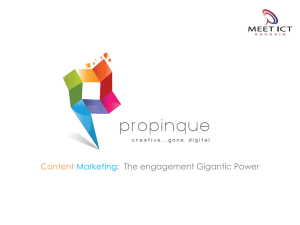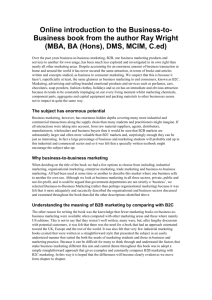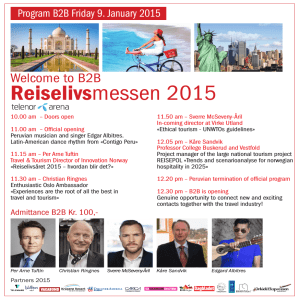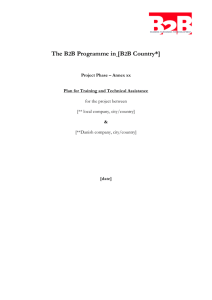7 B2B Marketing Myths
advertisement
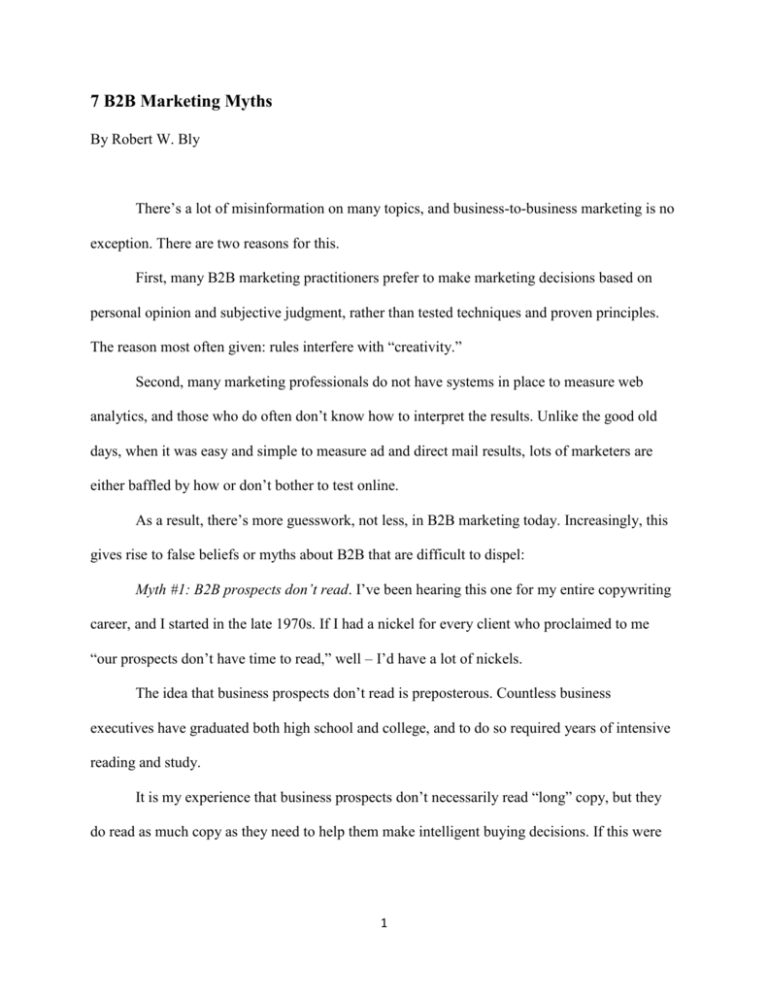
7 B2B Marketing Myths By Robert W. Bly There’s a lot of misinformation on many topics, and business-to-business marketing is no exception. There are two reasons for this. First, many B2B marketing practitioners prefer to make marketing decisions based on personal opinion and subjective judgment, rather than tested techniques and proven principles. The reason most often given: rules interfere with “creativity.” Second, many marketing professionals do not have systems in place to measure web analytics, and those who do often don’t know how to interpret the results. Unlike the good old days, when it was easy and simple to measure ad and direct mail results, lots of marketers are either baffled by how or don’t bother to test online. As a result, there’s more guesswork, not less, in B2B marketing today. Increasingly, this gives rise to false beliefs or myths about B2B that are difficult to dispel: Myth #1: B2B prospects don’t read. I’ve been hearing this one for my entire copywriting career, and I started in the late 1970s. If I had a nickel for every client who proclaimed to me “our prospects don’t have time to read,” well – I’d have a lot of nickels. The idea that business prospects don’t read is preposterous. Countless business executives have graduated both high school and college, and to do so required years of intensive reading and study. It is my experience that business prospects don’t necessarily read “long” copy, but they do read as much copy as they need to help them make intelligent buying decisions. If this were 1 not the case, there would be no need to post copy on the pages of your web site. And your Google Ad Words campaigns would generate zero clicks. Myth #2: There’s no difference between selling to a business prospect vs. selling to a consumer. A B2B ad agency owner I respected told me many years ago, “Whether he is at work or at home, the prospect is a human being first, a businessperson second.” But if there is no difference between business-to-business and business-to-consumer marketing, why are there webinars, books, conferences, advertising agencies, consultants, and publications focused specifically on B2B – and an audience that consumes them eagerly? Business-to-business is different than business-to-consumer in several different ways. To begin with, most B2B buying decisions are considered purchases, while many consumer purchases are impulse buys. In addition, most business buying decisions are made by committee, while consumer purchases are most often an individual’s decision. Also, consumer selling is usually a single-step process, while the sales cycle for B2B is often a multi-step process. Myth #3: Direct mail is dead. According to the Winterberry Group1, in 2010 marketers increased spending on direct mail by 3.1% to $45.2 billion. The Direct Marketing Association2 reports that spending in direct marketing overall grew at a 5.6% rate to $163 billion in 2011, generating nearly $2 trillion in sales. The ROI for direct marketing is $12 of sales per dollar of advertising expense vs. $5.24 for general advertising. So the idea that direct mail and traditional direct marketing are out of style, obsolete, or ineffective simply isn’t supported by the facts. Myth #4: QR codes are the new 800 numbers. QR codes are the latest new thing and cool-looking, and so the rush is on to incorporate them into every reply device on the planet. The 1 2 http://chiefmarketer.com/direct/news/winterberry-biegel-direct-mail-digital-rise-0126 http://www.the-dma.org/cgi/dispannouncements?article=1590 2 only problem is, millions of Americans, including me, don’t use smart phones3: two out of every three mobile device users in the U.S. do not own a smart phone. Many more prospects can respond to an 800 number; 234 million people age 13 and up have mobile devices in the U.S. Myth #5: Business-to-business is one homogenous market. People refer to B2B as if it’s a single market. The truth is there are many sub-segments within the B2B market. Based on company size, for instance, there is the SOHO market (small office/home office), SMB (small to medium size business), and Fortune 500 (large corporations), each with different needs and characteristics. The SOHO, for example, is spending her own money, and shares many characteristics with the consumer segment. The Fortune 500 buyer is locked into a rigid corporate hierarchy and requires buy-in by multiple parties before placing an order. A smaller SMB acts more like a SOHO and a larger more like a big corporate buyer. Myth #6: White papers are old hat. Many marketers share with me their opinion that white papers are overused and therefore much less effective today than a couple of years ago. That may be. The more pervasive a marketing technique, the more difficult it is to get yours noticed. Years ago, video cassettes were a hot marketing tool until too many marketers jumped on the bandwagon; then there effectiveness cooled off. Despite the flood of white papers in the market, they can still work well when integrated into a B2B marketing campaign. And although there may be a lot of white papers out there, the more specific you make yours, the fewer competitors there will be. Also, we’re hearing how marketing with content is the new mega-trend. Given that white papers are content, they would seem the perfect marketing communication for today’s contentbased marketing world. 3 http://www.inman.com/news/2011/08/30/number-smartphone-users-jumps-10 3 Myth #7: Talk only about benefits, not features. I can’t count how many times I’ve read an article or heard a talk by a marketing expert who proclaimed, “Use benefits, not features.” But this is patently absurd. To make your copy effective, you need both features and benefits. The benefits are what the prospect wants, and the features are what convince him that your product can deliver those benefits. An ad for IntraLinks in KM World (4/12, p. 3) says: “Now, IntraLinks Connect gives you the enterprise-strength, cloud-based collaboration platform to confidently share content with partners anywhere outside the corporate firewall, while controlling your content everywhere.” The benefit is securely sharing content with partners; the feature is the cloud-based collaboration platform. About the author: Bob Bly is a freelance copywriter and the author of 80 books including The White Paper Marketing Handbook (Racom). You can find him on the Web at www.bly.com, e-mail him at rwbly@bly.com, or phone 201-505-9451. ### 4


